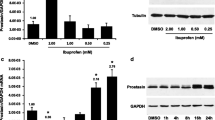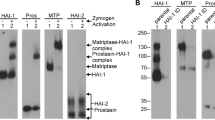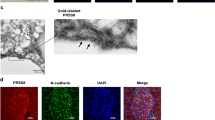Abstract
The epithelial extracellular serine protease activation cascade involves matriptase (PRSS14) and prostasin (PRSS8), capable of modulating epidermal growth factor receptor (EGFR) signaling. Matriptase activates prostasin by cleaving in the amino-terminal pro-peptide region of prostasin, presumably at the Arg residue of position 44 (R44) of the full-length human prostasin. Using an Arg-to-Ala mutant (R44A) human prostasin, we showed in this report that the cleavage of prostasin by matriptase is at Arg44. This prostasin proteolytic activation site is also cleaved by hepsin (TMPRSS1) to produce active prostasin capable of forming a covalent complex with protease nexin 1 (PN-1). An amino-terminal truncation of EGFR in the extracellular domain (ECD) was observed when the receptor was co-expressed with hepsin. Hepsin and matriptase appear to cleave the EGFR ECD at different sites, while the hepsin cleavage is not affected by active prostasin, which enhances the matriptase cleavage of EGFR. Using hepsin as the prostasin-activating protease in cells co-transfected with EGFR, we showed that active prostasin does not cleave the EGFR ECD directly in the cellular context. Purified active prostasin also does not cleave purified EGFR. Hepsin cleavage of EGFR is not dependent on receptor tyrosine phosphorylation, while the hepsin-cleaved EGFR is phosphorylated at Tyr1068 and no longer responsive to EGF stimulation. The cleavage of EGFR by hepsin does not result in increased phosphorylation of the downstream extracellular signal-regulated kinases (Erk1/2), an event inducible by the matriptase–prostasin cleavage of EGFR. The role of hepsin serine protease should be considered in future studies of epithelial biology concerning matriptase, prostasin, and EGFR.





Similar content being viewed by others
References
Netzel-Arnett S, Currie BM, Szabo R, Lin CY, Chen LM, Chai KX, Antalis TM, Bugge TH, List K (2006) Evidence for a matriptase-prostasin proteolytic cascade regulating terminal epidermal differentiation. J Biol Chem 281:32941–32945. doi:10.1074/jbc.C600208200
List K, Haudenschild CC, Szabo R, Chen W, Wahl SM, Swaim W, Engelholm LH, Behrendt N, Bugge TH (2002) Matriptase/MT-SP1 is required for postnatal survival, epidermal barrier function, hair follicle development, and thymic homeostasis. Oncogene 21:3765–3779. doi:10.1038/sj/onc/1205502
Leyvraz C, Charles RP, Rubera I, Guitard M, Rotman S, Breiden B, Sandhoff K, Hummler E (2005) The epidermal barrier function is dependent on the serine protease CAP1/Prss8. J Cell Biol 170:487–496. doi:10.1083/jcb.200501038
Seitz I, Hess S, Schulz H, Eckl R, Busch G, Montens HP, Brandl R, Seidl S, Schömig A, Ott I (2007) Membrane-type serine protease-1/matriptase induces interleukin-6 and -8 in endothelial cells by activation of protease-activated receptor-2: potential implications in atherosclerosis. Arterioscler Thromb Vasc Biol 27:769–775. doi:10.1161/01.ATV.0000258862.61067.14
Chen M, Chen LM, Lin CY, Chai KX (2008) The epidermal growth factor receptor (EGFR) is proteolytically modified by the Matriptase-Prostasin serine protease cascade in cultured epithelial cells. Biochim Biophys Acta 1783:896–903. doi:10.1016/j.bbamcr.2007.10.019
Bruns JB, Carattino MD, Sheng S, Maarouf AB, Weisz OA, Pilewski JM, Hughey RP, Kleyman TR (2007) Epithelial Na+ channels are fully activated by furin- and prostasin-dependent release of an inhibitory peptide from the gamma-subunit. J Biol Chem 282:6153–6160. doi:10.1074/jbc.M610636200
Planès C, Caughey GH (2007) Regulation of the epithelial Na+ channel by peptidases. Curr Top Dev Biol 78:23–46. doi:10.1016/S0070-2153(06)78002-4
Szabo R, Molinolo A, List K, Bugge TH (2007) Matriptase inhibition by hepatocyte growth factor activator inhibitor-1 is essential for placental development. Oncogene 26:1546–1556. doi:10.1038/sj.onc.1209966
Fan B, Wu TD, Li W, Kirchhofer D (2005) Identification of hepatocyte growth factor activator inhibitor-1B as a potential physiological inhibitor of prostasin. J Biol Chem 280:34513–34520. doi:10.1074/jbc.M502119200
Herter S, Piper DE, Aaron W, Gabriele T, Cutler G, Cao P, Bhatt AS, Choe Y, Craik CS, Walker N, Meininger D, Hoey T, Austin RJ (2005) Hepatocyte growth factor is a preferred in vitro substrate for human hepsin, a membrane-anchored serine protease implicated in prostate and ovarian cancers. Biochem J 390:125–136. doi:10.1042/BJ20041955
Béliveau F, Désilets A, Leduc R (2009) Probing the substrate specificities of matriptase, matriptase-2, hepsin and DESC1 with internally quenched fluorescent peptides. FEBS J 276:2213–2226. doi:10.1111/j.1742-4658.2009.06950.x
Chen LM, Skinner ML, Kauffman SW, Chao J, Chao L, Thaler CD, Chai KX (2001) Prostasin is a glycosylphosphatidylinositol-anchored active serine protease. J Biol Chem 276:21434–21442. doi:10.1074/jbc.M011423200
Chen M, Fu YY, Lin CY, Chen LM, Chai KX (2007) Prostasin induces protease-dependent and independent molecular changes in the human prostate carcinoma cell line PC-3. Biochim Biophys Acta 1773:1133–1140. doi:10.1016/j.bbamcr.2007.04.013
Wu Q, Yu D, Post J, Halks-Miller M, Sadler JE, Morser J (1998) Generation and characterization of mice deficient in hepsin, a hepatic transmembrane serine protease. J Clin Invest 101:321–326. doi:10.1172/JCI1617
List K, Hobson JP, Molinolo A, Bugge TH (2007) Co-localization of the channel activating protease prostasin/(CAP1/PRSS8) with its candidate activator, matriptase. J Cell Physiol 213:237–245. doi:10.1002/jcp.21115
Vasioukhin V (2004) Hepsin paradox reveals unexpected complexity of metastatic process. Cell Cycle 3:1394–1397
Srikantan V, Valladares M, Rhim JS, Moul JW, Srivastava S (2002) HEPSIN inhibits cell growth/invasion in prostate cancer cells. Cancer Res 62:6812–6816
Tanimoto H, Yan Y, Clarke J, Korourian S, Shigemasa K, Parmley TH, Parham GP, O’Brien TJ (1997) Hepsin, a cell surface serine protease identified in hepatoma cells, is overexpressed in ovarian cancer. Cancer Res 57:2884–2887
Matsuo T, Nakamura K, Takamoto N, Kodama J, Hongo A, Abrzua F, Nasu Y, Kumon H, Hiramatsu Y (2008) Expression of the serine protease hepsin and clinical outcome of human endometrial cancer. Anticancer Res 28:159–164
Betsunoh H, Mukai S, Akiyama Y, Fukushima T, Minamiguchi N, Hasui Y, Osada Y, Kataoka H (2007) Clinical relevance of hepsin and hepatocyte growth factor activator inhibitor type 2 expression in renal cell carcinoma. Cancer Sci 98:491–498. doi:10.1111/j.1349-7006.2007.00412.x
Miao J, Mu D, Ergel B, Singavarapu R, Duan Z, Powers S, Oliva E, Orsulic S (2008) Hepsin colocalizes with desmosomes and induces progression of ovarian cancer in a mouse model. Int J Cancer 123:2041–2047. doi:10.1002/ijc.23726
Nakamura K, Takamoto N, Abarzua F, Hongo A, Kodama J, Nasu Y, Kumon H, Hiramatsu Y (2008) Hepsin inhibits the cell growth of endometrial cancer. Int J Mol Med 22:389–397
Chen LM, Hodge GB, Guarda LA, Welch JL, Greenberg NM, Chai KX (2001) Down-regulation of prostasin serine protease: a potential invasion suppressor in prostate cancer. Prostate 48:93–103
Chen LM, Chai KX (2002) Prostasin serine protease inhibits breast cancer invasiveness and is transcriptionally regulated by promoter DNA methylation. Int J Cancer 97:323–329. doi:10.1002/ijc.1601
Chen LM, Wang C, Chen M, Marcello MR, Chao J, Chao L, Chai KX (2006) Prostasin attenuates inducible nitric oxide synthase expression in lipopolysaccharide-induced urinary bladder inflammation. Am J Physiol Renal Physiol 291:F567–F577. doi:10.1152/ajprenal.00047.2006
Acknowledgments
This work was supported by the Florida Biomedical Research Program Grant 06NIR-03 (L.-M. Chen); the Susan G. Komen for the Cure Grant BCTR0707538 (K.X. Chai); and NIH Grants R01-CA-104944 and R01-CA-096851 (C.-Y. Lin).
Author information
Authors and Affiliations
Corresponding author
Rights and permissions
About this article
Cite this article
Chen, M., Chen, LM., Lin, CY. et al. Hepsin activates prostasin and cleaves the extracellular domain of the epidermal growth factor receptor. Mol Cell Biochem 337, 259–266 (2010). https://doi.org/10.1007/s11010-009-0307-y
Received:
Accepted:
Published:
Issue Date:
DOI: https://doi.org/10.1007/s11010-009-0307-y




